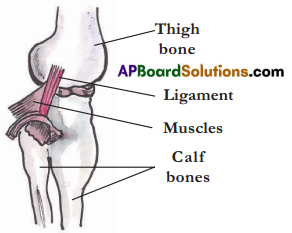These TS 6th Class Science Important Questions 14th Lesson Movements in Animals will help the students to improve their time and approach.
TS 6th Class Science Important Questions 14th Lesson Movements in Animals
Question 1.
What are muscles ? What are their uses?
Answer:
The tender fleshy structures lie beneath the skin are called muscles.
They are usually around the shoulders and hips.
They help us in running, walking, working etc.
![]()
Question 2.
What are ligaments?
Answer:
The special fibres which joins the two bones together in a special way are called ligaments.
Question 3.
Explain how backbone acts like a spring.
Answer:
Indeed our backbone acts like a spring. For example
- When we do the exercise in which we stand straight up and touch the floor with our palms by bending our body without bending knees.
- We do the exercise in which we bend our body to the left and right at the wrist.
Question 4.
How many vertebrae are there in the back bone of an infant?
Answer:
There are 33 vertebrae in the back bone of an infant.
Question 5.
Mention the types of joints in human beings and where they are situated with examples?
Answer:
| Type of joint | Body part |
| 1. Hinge joint | Elbow and knee |
| 2. Ball and socket joint | Shoulder |
| 3. Pivot joint | Neck region |
| 4. Spring joint | Back bone |
| 5. Fixed joint | Skull and upper jaw |
Question 6.
How do you identify backbone of your friend ?
Answer:
- We ask our friend to stand up, bend forward at the waist and try to touch his toes with his palms.
- Run a finger along the centre of his back from below the neck.
- A long structure running down the middle of his back is called the back bone (Spinal column).
- The small bones that make up this backbone are called vertebrae.
- The spinal cord passes through the vertebrae of the backbone.
![]()
Question 7.
What are the differences between ball and socket joint and Hinge joint?
Answer:
| Ball and Socket joint | Hinge joint |
| 1. This is present between shoulder bones and arm. | This is present between our arm and elbow and also at knee. |
| 2. A joint made by fitting a ball into a socket. | A joint moves like hinges of the door. |
| 3. In this joint, bones can rotate easily in all directions. | It shows side to side movement in certain positions of the hands and legs |
Question 8.
What questions would you ask about importance of joints in the human body?
Answer:
- How joints help us in movement?
- Where are the joints located in our body?
- Which joint helps us bending our body easily?
- Are all the joints working in similar way?
Question 9.
If there is no pivot joint or neck joint what problem will you face?
Answer:
If there is no pivot joint we can’t move our head up – down and side to side.
Question 10.
Guess the problem that arise due to problems or fractures of back bone?
Answer:
If back bone or vertebrae is broken or fractured we can’t bend, rotate and move up – down our body.
Question 11.
How do you find cartilage bones are our body? Write the activity you do. Where do you find them?
Answer:
- Our ears are held, pressed and bent with the help of fingers.
- In the same way nose is also observed.
- A flexible bone is seen at external ear and tip of nose which is called cartilage bone.
![]()
Question 12.
Observe the following animals, how they move from one place to another. Which body parts are for moving and how does the animal move?
a. Cow b. Human c. Snake d. Bird e. Insect f. Fish
(Or)
Mention the body parts of following animals that help in their movement?
Answer:
| Animal | Body part used for moving | How does the animal move ? |
| Cow | legs | walks, runs |
| Human | legs, hands | walks, jumps |
| Snake | body | crawls |
| Bird | wings, legs | hops, flies |
| Insect | legs, wings | walks, flies |
| Fish | body, fins | swim, jumps |
Question 13.
Read the table and complete it.
| Name of the animal | Organ used for locomotion | Method of locomotion |
| Monkey | ||
| Snake | ||
| Frog | ||
| Bird | ||
| Bat | ||
| Fish | ||
| Crocodile | ||
| Wasp |
Answer:
| Name of the animal | Organ used for locomotion | Method of locomotion |
| Monkey | legs | jumping and running |
| Snake | Abdominal surface | crawling |
| Frog | legs | hopping |
| Bird | wings, legs | walking, flying |
| Bat | wings | flying |
| Fish | fins | swimming |
| Crocodile | webbed feet | swimming |
| Wasp | wings | flying |
a) What are the organisms that fly in the air?
Answer: Bird, bat, wasp
b. What are the organisms that swim in the water?
Answer: Fish, crocodile
![]()
Question 14.
Draw the diagram of ligament with thigh bone and calf bones.
Answer:

Question 15.
How can you appreciate locomotion in animals?
Answer:
- Movement or locomotion is an important function in every living organisms.
- It is interesting to watch ants running hurriedly in a line.
- Sqrirrels and monkeys jump on trees.
- We will enjoy watching various locomotions in the animal kingdom.